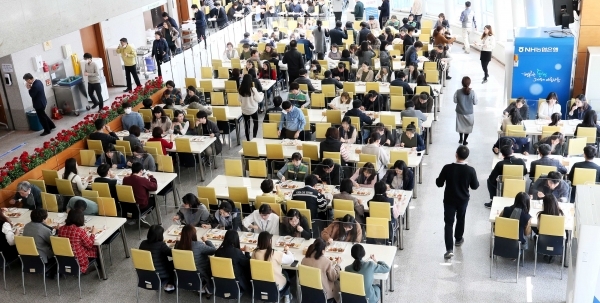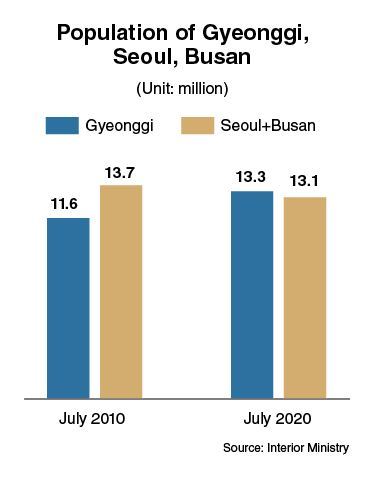
Workers at Yongin City Hall in Gyeonggi Province eat lunch at a cafeteria earlier this year. The city, which has taken a part in the province’s fast-growing population, saw the number of residents come to 1.07 million as of July. This marked a 25.7 percent increase from 850,000 a decade earlier. (Yongin City)
SEJONG -- It has been found that residents in Gyeonggi Province outnumbered those in Seoul plus Busan for a year with the gap continuously widening each month.
According to the Ministry of Interior and Safety, the population of Gyeonggi Province overtook the collective figure for the nation’s largest and second-largest cities in August 2019, which marked the first time in history since the nation began compiling the data. The figures were 13.19 million vs. 13.16 million.
Further, the gap has continued to widen over the past year. As of July 2020, Gyeonggi outstripped Seoul plus Busan in population by 233,000 -- 13.35 million vs. 13.11 million.
The tallies for Seoul and Busan were at 9.71 million and 3.4 million, respectively, the two having begun to shrink.
A problem involving the demographic changes of the three areas lies in the fact that the decline in the population of major cities has not benefited the balanced regional growth via distribution of residents.
Young jobseekers in major cities and provinces nationwide rushed to Seoul in the 1970s, ’80s and ’90s. Now a large portion of them, whose workplaces are located in Seoul, are choosing to live in satellite cities in Gyeonggi Province due to skyrocketing apartment prices in the capital.
As a result, there are three cities in Gyeonggi Province with populations of more than 1 million -- Suwon, Goyang and Yongin. Suwon’s population outstrips that of Ulsan, one of Korea’s seven large metropolitan cities, by 1.19 million to 1.14 million.

(Graphic by Kim Sun-young/The Korea Herald)
Among other mega-cities in the province are Seongnam with 930,000, Hwaseong with 830,000, Bucheon with 820,000 and Namyangju with 700,000. Some others, such as Gimpo, Euijeongbu, Anyang and Pyeongtaek, outstrip Sejong (with 340,000 as the nation’s administrative city) in population.
When it comes to Gyeonggi, there could be a lack of efficacy carrying out provincial administrative policies from the record-high population, which is renewing each month.
Some researchers had raised the necessity of vitalizing social discussions on splitting the province into South Gyeonggi and North Gyeonggi. But the talks have yet to resurface under the Moon Jae-in administration.
“The population of Gyeonggi is higher than those of Sweden, Portugal, Greece and Austria. And the figure is higher by more than 100 percent, compared to the respective tallies for Denmark, Norway, Ireland and New Zealand,” said an analyst in Seoul.
“Despite the fast expanding, many of the cities in the province have only the function of residential towns and retail services, as a dominant portion of the core enterprises and universities are still headquartered in Seoul,” he said.
The Interior Ministry data showed that Gyeonggi saw the number of residents surge by 1.74 million (15 percent) over the past decade, from 11.6 million in July 2010.
Over the corresponding period, the population of Seoul and Busan declined by 4.6 percent and 3.7 percent, respectively. The entire population of Korea increased by 3.7 percent.
As of July 2020, one out of every four South Koreans (or 25.7 percent) were residing in Gyeonggi.
Amid the population decline across the country, which de facto started in December 2019, Gyeonggi is projected to fast approach the collective figure for the number of residents in the other eight provinces -- which posted 15.58 million in July -- in the coming years.
By Kim Yon-se (kys@heraldcorp.com)







